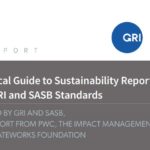Environmental communications is a discipline that’s coming of age. Whole armies of consultants have a wealth of advice, encouragement and cajoling on offer. Most of it is directed to business and rightly so, says Sharon O’Shea of The Greenhouse, talking here to Freddie Lawrence.
When it comes to changing public attitudes, commercial endorsement usually has far more impact than any amount of education and persuasion from government or pressure groups. Take the cheery cornflake packet. Its messages about fibre, fats and vitamins make remarkably interesting breakfast reading. This kind of contribution to public awareness of health issues was sparked in the Seventies, when food manufacturers and health educationists set aside their suspicions to mount mutually beneficial promotions, in which product packaging became both medium and message.
The same process can work for the environment. As far as consumer products are concerned, it’s a highly beneficial chain reaction. By communicating a green message, a company informs and educates the consumer, encourages relevant stakeholders, gains goodwill from environmentalists and even, perhaps, holds unwanted legislation at bay. Whatever the reason, pragmatic or otherwise, the environment wins.
After all, you can’t have too much awareness. Even a humble cornflake box made from recycled cardboard is a subliminal message that the environment matters. And beyond the supermarket shelf lies a wider world of business where customers, investors, corporate stakeholders, legislators and environmentalists increasingly expect corporations to deliver on that triple bottom line economic, social and environmental.
So it’s not only the obvious potential polluters who need to see the strategic sense in communicating green commitment. Business of any stripe ignores this at its peril. Take an issue as fundamental as attracting investment and consider that, in the US, the once fringe market of socially responsible investment (SRI) is now estimated to represent one dollar in every eight under professional management.
All in all, being seen to be green is clearly beneficial for business, deserving an automatic place in what the PR consultants like to call the marketing mix. So, how best to communicate those environmental credentials?
Many companies rely first, foremost, and indeed often solely, on an environmental report. And what do they produce? Too often, something hopelessly detailed to the point of well intentioned but indigestible corporate paranoia. "Never before in the field of human endeavour," as Martin Wright wrote in Green Futures [GF30], "has so much effort been expended… for a publication read by so few." Equally misguided is something smacking more of the self-congratulatory sales leaflet than an honest warts and all account of environmental stewardship. Either way, it’s a communication that hasn’t communicated.
The formal report has its place. It may well one day be mandatory. But many more tools and techniques once used only to publicise products and services are available when a business comprehensively commits to promoting the environmental dimension.
Another thing: environmental communications don’t have to look worthy. Design them with the visual impact usually reserved for promoting products. Conversely, whatever you communicate, use materials like paper and printing ink derived from sustainable sources. Then boast about it.
All these methods put a public face on the company’s commitment to sustainability. They proclaim that key article of marketing faith: We care. The key, as with all communications, is repetition. Lots of repetition. Remember that information is giving out. But communication is getting through.
Freddie Lawrence is a freelance corporate communications consultant.
Sharon O’Shea is communications director of environmental communications specialists The Greenhouse .



